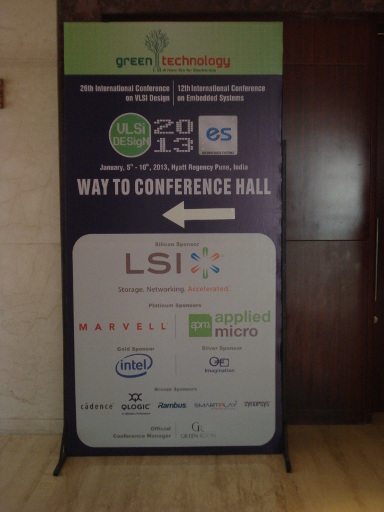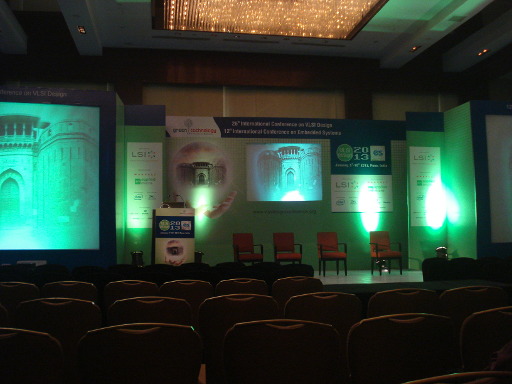The 26th International Conference on VLSI Design 2013 and the 12th International Conference on Embedded Systems was held at the Hyatt Regency, Pune, India between January 5-10, 2013. The first two days were tutorial sessions, while the main conference began on Monday, January 7, 2013.

Day 1: Tutorial
On the first day, I attended the tutorial on “Concept to Product – Design, Verification & Test: A Tutorial” by Prof. Kewal Saluja, and Prof. Virendra Singh. Prof. Saluja started the tutorial with an introduction and history of VLSI. An overview of the VLSI realization process was given with an emphasis on synthesis. The theme of the conference was “green” technology, and hence the concepts of low power design were introduced. The challenges of multi-core and high performance design including cache coherence were elaborated. Prof. Singh explained the verification methodologies with an example of implementing a DVD player. Simulation and formal verification techniques were compared, with an overview on model checking. Prof. Saluja explained the basics of VLSI testing, differences between verification and testing, and the various testing techniques used. The challenges in VLSI testing were also discussed.
Day 2: Tutorial
On the second day, I attended the tutorial on “Formal Techniques for Hardware/Software Co-Verification” by Prof. Daniel Kroening, and Prof. Mandayam Srinivas. Prof. Kroening began the tutorial with the motivation for formal methods. Examples on SAT solvers, boundary model checking for hardware, and bounded program analysis for C programs were explained. Satisfiability modulo theories for bit-vectors, arrays and functions were illustrated with numerous examples. In the afternoon, Prof. Srinivas demoed formal verification for both Verilog and C. He shared the results of verification done for both a DSP and a microprocessor. The CProver tool has been released under a CMBC license. After discussion with Fedora Legal, and Prof. Kroening, it has been updated to a BSD license for inclusion in Fedora. The presentation slides used in the tutorial are available.
Day 3: Main conference
The first day of the main conference began with the keynote by Mr. Abhi Talwalker, CEO of LSI, on “Intelligent Silicon in the Data-centric Era”. He addressed the challenges in bridging the data deluge gap, latency issues in data centers, and energy efficient buildings. The second keynote of the day was given by Dr. Ruchir Puri, IBM Fellow, on “Opportunities and Challenges for High Performance Microprocessor Designs and Design Automation”. Dr. Ruchir spoke about the various IBM multi-core processors, and the challenges facing multi-core designs – software parallelism, socket bandwidth, power, and technology complexity. He also said that more EDA innovation needs to come at the system level.

After the keynote, I attended the “C1. Embedded Architecture” track sessions. Liang Tang presented his paper on “Processor for Reconfigurable Baseband Modulation Mapping”. Dr. Swarnalatha Radhakrishnan then presented her paper on “A Study on Instruction-set Selection Using Multi-application Based Application Specific Instruction-Set Processors”. She explained about ASIPs (Application Specific Instruction Set Processor), and shared test results on choosing specific instruction sets based on the application domain. The final paper for the session was presented by Prof. Niraj K. Jha on “Localized Heating for Building Energy Efficiency”. He and his team at Princeton have used ultrasonic sensors to implement localized heating. A similar approach is planned for lighting as well.
Post-lunch, I attended the sessions for the track “B2. Test Cost Reduction and Safety”. The honourable chief minister of Maharashtra, Shri. Prithviraj Chavan, arrived in the afternoon to formally inaugurate the conference. He is an engineer who graduated from the University of California, Berkeley, and said that he was committed to put Pune on the semiconductor map. The afternoon keynote was given by Mr. Kishore Manghnani from Marvell, on “Semiconductors in Smart Energy Products”. He primarily discussed about LEDs, and their applications. This was followed by a panel discussion on “Low power design”. There was an emphasis to create system level, software architecture techniques to increase leverage in low power design. For the last track of the day, I attended the sessions on “C3. Design and Synthesis of Reversible Logic”. The Keccak sponge function family has been chosen to become the SHA-3 standard.
Day 4: Main conference
The second day of the main conference began with a recorded keynote by Dr. Paramesh Gopi, AppliedMicro, on “Cloud computing needs at less power and low cost” followed by a talk by Mr. Amal Bommireddy, AppliedMicro, on “Challenges of First pass Silicon”. Mr. Bommireddy discussed the factors affecting first pass success – RTL verification, IP verification, physical design, routing strategies, package design, and validation board design. The second keynote of the day was by Dr. Louis Scheffer from the Howard Hughes Medical Institute, on “Deciphering the brain, cousin to the chip”. It was a brilliant talk on applying chip debugging techniques to inspect and analyse how the brain works.
After the keynote, I visited the exhibition hall where companies had their products displayed in their respective stalls. AppliedMicro had a demo of their X-gene ARM64 platform running Ubuntu. They did mention to me that Fedora runs on their platform. Marvell had demonstrated their embedded and control solutions running on Fedora. ARM had their mbed.org and embeddedacademic.com kits on display for students. Post-lunch, was an excellent keynote by Dr. Vivek Singh, Intel Fellow, titled “Duniyaa Maange Moore!”. He started with what people need – access, connectivity, education, and healthcare, and went to discuss the next in line for Intel’s manufacturing process. The 14nm technology is scheduled to be operational by end of 2013, while 10nm is planned for 2015. They have also started work on 7nm manufacturing processes. This was followed by a panel discussion on “Expectations of Manufacturing Sector from Semiconductor and Embedded System Companies” where the need to bridge the knowledge gap between mechanical and VLSI/embedded engineers was emphasized.
Day 5: Main conference
The final day of the main conference began with the keynote by Dr. Vijaykrishnan Narayanan on “Embedded Vision Systems”, where he showed the current research in intelligent cameras, augmented reality, and interactive systems. I attended the sessions for the track “C7. Advances in Functional Verification”, and “C8. Logic Synthesis and Design”. Post-lunch, Dr. Ken Chang gave his keynote on “Advancing High Performance System-on-Package via Heterogeneous 3-D Integration”. He said that Intel’s 22nm Ivy Bridge which uses FinFETs took nearly 15 years to productize, but look promising for the future. Co(CoS) Chip on Chip on Substrate, and (CoW)oS Chip on Wafer on Substrate technologies were illustrated. Many hardware design houses use 15 FPGAs on a board for testing. The Xilinx Virtex-7HT FPGA has analog, memory, and ARM microprocessor integrated on a single chip giving a throughput of 2.8 Terabits/second. He also mentioned that Known Good Die (KGD) methodologies are still emerging in the market. For the last track of the conference, I attended the sessions on “C9. Advances in Circuit Simulation, Analysis and Design”.

Thanks to Red Hat for sponsoring me to attend the conference.
About the Author – Shakthi Kannan
Shakthi Kannan is a Senior Software Engineer with Red Hat in Pune, and is also a very active member of the open source community. For more details about him, see his Linkedin Profile, or his blog.


![Reblog this post [with Zemanta]](http://img.zemanta.com/reblog_b.png?x-id=dcfc0eae-c57b-45af-804d-63e201cd4a18)